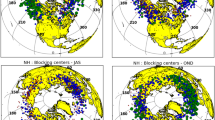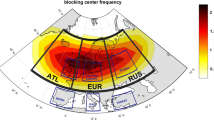Abstract
Two principal modes of Northern Hemisphere (NH) wintertime blocking variability are identified to examine the possible relationships between regional blocking activities and to understand how they are linked. The first mode of NH blocking variability is characterized by regional blocking activities including the North Pacific (PA), Greenland, European, and Ural-Siberian regions. There exists dominant PA blocking associated with the negative North Pacific Oscillation (NPO) pattern. The second mode shows a zonally dipole pattern between PA and North Atlantic (AT) blockings. It is more related to AT blocking, such that there is strong coupling with the negative North Atlantic Oscillation (NAO) pattern. Correlation analysis with major climate variability patterns revealed that both the NPO and NAO may modulate the two leading modes of NH blocking variability. Also, the NPO and Arctic Oscillation (AO) can simultaneously be associated with the blocking occurrence over both the PA and AT basins. The negative phase of the NPO (AO) is favorable for the in- phase (out-of-phase) relationship between west of (south of) PA and south of (west of) AT blocking sectors. This occurs because NH blocking occurrence is dependent on the phase of the AO, especially in the negative NPO pattern. If the NPO and AO are in phase (out of phase), NH blocking occurrence is more enhanced (weakened), in particular, having higher frequency over the Pacific and higher (lower) frequency over the Northwest Atlantic.









Similar content being viewed by others
References
Barriopedro D, Garcia-Herrera R, Lupo AR, Hernandez E (2006) A climatology of Northern Hemispheric blocking. J Clim 19:1042–1063
Barriopedro D, Garcia-Herrera R, Trigo RM (2010) Application of blocking diagnosis methods to general circulation models. Part I: a novel detection scheme. Clim Dyn 35:1373–1391
Cattiaux J, Vautard R, Cassou C, Yiou P, Masson-Delmotte V, Codron F (2010) Winter 2010 in Europe: a cold extreme in a warming climate. Geophys Res Lett 37:L20704. doi:10.1029/2010GL044613
Chen TC, Yoon JH (2002) Interdecadal variation of the North Pacific wintertime blocking. Mon Wea Rev 130:3136–3143
Cheung HN, Zhou W, Mok HY, Wu MC (2012) Relationship between Ural-Siberian blocking and the East Asian winter monsoon in relation to the Arctic Oscillation and the El Niño-Southern Oscillation. J Clim 25:4242–4257
Croci-Maspoli M, Schwierz C, Davies HC (2007a) A multifaceted climatology of atmospheric blocking and its recent linear trend. J Clim 20:633–649
Croci-Maspoli M, Schwierz C, Davies HC (2007b) Atmospheric blocking: space-time links to the NAO and PNA. Clim Dyn 29:713–725
Davini P, Cagnazzo C, Gualdi S, Navarra A (2012a) Bidimensional diagnostics, variability and trends of Northern Hemisphere blocking. J Clim 25:6496–6509
Davini P, Cagnazzo C, Neale R, Tribbia J (2012b) Coupling between Greenland blocking and the North Atlantic Oscillation pattern. Geophys Res Lett 39:L14701. doi:10.1029/2012GL052315
Dee DP et al (2011) The ERA-interim reanalysis: configuration and performance of the data assimilation system. Q J R Meteorol Soc 137(656):553–597
Dole R, Gordon N (1983) Persistent anomalies of the extratropical Northern Hemisphere wintertime circulation—geographical-distribution and regional persistence characteristics. Mon Wea Rev 111:1567–1586
Dole R et al (2011) Was there a basis for anticipating the 2010 Russian heat wave? Geophys Res Lett 38:L06702. doi:10.1029/2010GL046582
Dunn-Sigouin E, Son SW, Lin H (2013) Evaluation of Northern Hemisphere blocking climatology in the Global Environment Multiscale (GEM) model. Mon Wea Rev 141:707–727
Huang F, Zhou FX, Qian XD (2002) Interannual and decadal variability of the North Pacific blocking and its relationship to SST, teleconnection and storm tracks. Adv Atmos Sci 19:807–819
Kalnay E et al (1996) The NCEP/NCAR 40-year reanalysis project. Bull Am Meteor Soc 77:437–471
Lee SS, Lee JY, Wang B, Jin FF, Lee WJ, Ha KJ (2011) A comparison of climatological subseasonal variations in the wintertime storm track activity between the North Pacific and Atlantic: local energetics and moisture effect. Clim Dyn doi:10.1007/s00382-011-1027-z
Lee SS, Lee JY, Wang B, Ha KJ, Heo KY, Jin FF, Straus DM, Shukla J (2012) Interdecadal changes in the storm track activity over the North Pacific and North Atlantic. Clim Dyn 39(1):313–327. doi:10.1007/s00382-011-1188-9
Lee JY, Lee SS, Wang B, Ha KJ, Jhun JG (2013a) Seasonal prediction and predictability of the Asian winter temperature variability. Clim Dyn 41(3–4):573–587. doi:10.1007/s00382-012-1588-5
Lee SS, Kim SH, Jhun JG, Ha KJ, Seo YW (2013b) Robust warming over East Asia during boreal winter monsoon and its possible causes. Environ Res Lett 8(3):34001. doi:10.1088/1748-9326/8/3/034001
Luo D, Wan H (2005) Decadal variability of wintertime North Atlantic and Pacific blockings: a possible cause. Geophys Res Lett 32:L23810. doi:10.1029/2005GL024329
Nakamura H, Nakamura M, Anderson JL (1997) The role of high- and low-frequency dynamics in blocking formation. Mon Weather Rev 125:2074–2093
Park TW, Ho CH, Yang S (2011) Relationship between the Arctic Oscillation and cold surges over East Asia. J Clim 24:68–83
Rayner NA, Parker DE, Horton EB, Folland CK, Alexander LV, Rowell DP, Kent EC, Kaplan A (2003) Global analyses of sea surface temperature, sea ice, and night marine air temperature since the late nineteenth century. J Geophys Res 108(D14):4407. doi:10.1029/2002JD002670
Renwick JA, Wallace JM (1996) Relationships between North Pacific wintertime blocking, El Niño, and the PNA pattern. Mon Weather Rev 124:2071–2076
Rex DF (1950) Blocking action in the middle troposphere and its effect upon regional climate. Part II: the climatology of blocking action. Tellus 2:275–301
Rienecker MM et al (2011) MERRA: NASA’s Modern-Era retrospective analysis for research and applications. J Clim 24:3624–3648
Sausen R, König W, Sielmann F (1995) Analysis of blocking events from observations and ECHAM model simulations. Tellus 47:421–438
Thompson DWJ, Wallace JM (1998) The Arctic Oscillation signature in the wintertime geopotential height and temperature fields. Geophys Res Lett 25:1297–1300
Tibaldi S, Molteni F (1990) On the operational predictability of blocking. Tellus 42A:343–365
Trigo R, Trigo I, DaCamara C, Osborn T (2004) Climate impact of the European winter blocking episodes from the NCEP/NCAR reanalyses. Clim Dyn 23:17–28
Uppala SM et al (2005) The ERA-40 re-analysis. Q J R Meteorol Soc 131:2961–3012
Walker GT, Bliss EW (1932) World weather V. Meml R Meteorol Soc 4:53–84
Wallace JM, Gutzler DS (1981) Teleconnections in the geopotential height field during the Northern Hemisphere winter. Mon Weather Rev 109:784–812
Yeh SW, Kim CH (2010) Recent warming in the Yellow/East China Sea during winter and the associated atmospheric circulation. Continental Shelf Res 30:1428–1434
Acknowledgments
This research was supported by a GRL grant of the National Research Foundation (NRF) funded by the Korea government (MEST) (No. 2011-0021927). This study was also financially supported by the National Research Foundation of Korea (NRF) grant funded by the Korea government (MEST) (No. 2012R1A2A2A01008501). We thank both Prof. Seok-Woo Son and Etienne Dunn-Sigouin for providing the block detection code. This paper was further improved by their valuable comments and suggestions from Dr. Kyung-Sook Yun, Dr. Sun-Seon Lee, and the anonymous reviewers.
Author information
Authors and Affiliations
Corresponding author
Appendix
Appendix
1.1 A hybrid blocking index
To obtain the two-dimensional spatial distribution of atmospheric blocking, the following five-step procedure was applied.
Step 1: Compute the anomaly field, \( {\text{Z}}^{{\prime}} \), as described by Sausen et al. (1995).
where \( {\text{Z}} \) is the 500-hPa geopotential height divided by the sine of latitude (Dole and Gordon 1983), \( \bar{Z} \) is the running annual-mean of Z centered on a given day, and \( \hat{Z} \) is the mean seasonal cycle derived from Z *, which is the running-monthly mean of \( {\text{Z}} - \bar{Z} \) centered on a given day.
Step 2: Identify the closed positive contours of Z ′, satisfying the minimum amplitude (A) and spatial scale (S).
Step 3: Track the blocking anomalies in time, ensuring the minimum overlap (O) in blocking area within 2 days. As such, it remains only quasi-stationary systems.
Step 4: If the reversal of the meridional gradient of absolute geopotential height is satisfied around the blocking anomalies, it can be seen that they (the detected anomalies) block the flow.
Step 5: If all of these conditions are satisfied for a duration criterion (D), the anomalies are finally labeled as blocking highs (See Dunn-Sigouin et al. (2013) for further details of the index).
For the threshold values used in this study, (A) was assumed to be 1.5 standard deviations of the geopotential height anomalies over 30–90°N for a 3-month period centered at a given month, (S) = 2.5 × 106 km2, (O) = 50 %, and (D) = 5 days.
Rights and permissions
About this article
Cite this article
Kim, SH., Ha, KJ. Two leading modes of Northern Hemisphere blocking variability in the boreal wintertime and their relationship with teleconnection patterns. Clim Dyn 44, 2479–2491 (2015). https://doi.org/10.1007/s00382-014-2304-4
Received:
Accepted:
Published:
Issue Date:
DOI: https://doi.org/10.1007/s00382-014-2304-4




